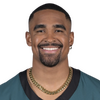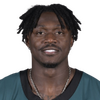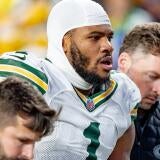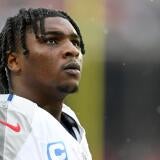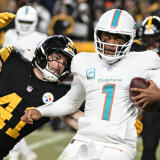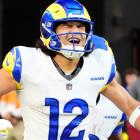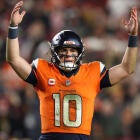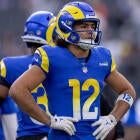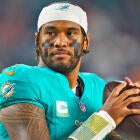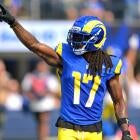Eagles vs. 49ers how to watch: Time, TV channel, streaming, key matchups for 2023 NFC Championship Game
The NFC's top two teams battle Sunday for a spot in Super Bowl LVII
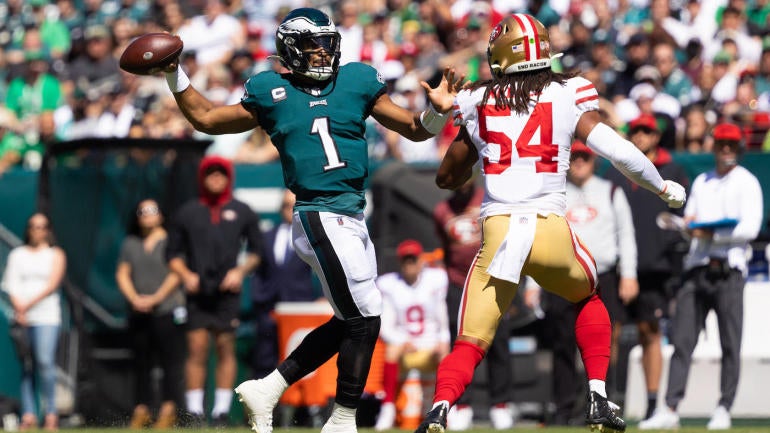
Let's not waste time with a long preamble. It's Championship Sunday in the NFL and this first game has kicked off. In the NFC Championship, the No. 1 seed and NFC East champion Philadelphia Eagles will play host to the No. 2 seed and NFC West champion San Francisco 49ers.
These were the two best teams in the conference for the significant majority of the season, and they will duke it out for the right to represent the NFC in the Super Bowl. Before we break down the matchup, here's a look at how you can watch the game.
How to watch
Date: Sunday, Jan. 29 | Time: 3 p.m. ET
Location: Lincoln Financial Field (Philadelphia)
TV: Fox | Stream: fuboTV (try for free)
Odds: Eagles -2.5, O/U 46 (Courtesy of Caesars Sportsbook)
When the 49ers have the ball
Let's start by talking about Brock Purdy, because how he handles the Philadelphia pass rush might be the tipping point of this game.
Prior to last week's game against the Cowboys, Purdy had dropped back to pass 177 times since taking over for Jimmy Garoppolo back in Week 13. He'd completed 110-of-161 passes (68.3%) for 1,308 yards (8.12 per attempt), 13 touchdowns and just three interceptions. He was sacked 11 times, and faced pressure at an almost exactly league-average rate (32.8% vs. 32.6%). The Dallas rush was able to get after Purdy a bit more regularly last week (48.5% pressure rate, per Tru Media), and though Purdy was sacked only twice and did not get picked off (though he did have one potential interception dropped), his efficiency took a hit (7.38 yards per attempt).
During the regular season, the Cowboys were the league's best team at getting pressure (43.3% of opponent dropbacks), but the Eagles were right behind them in second place (38.4%). And the Eagles were quite a bit better at converting pressure into sacks: 11.2% of Philly's pressures resulted in quarterback takedowns (first in the NFL), compared with 8.9% of Dallas' pressures (second). That difference could be incredibly meaningful in this matchup.
The Eagles can throw even more bodies at their pass rush than the Cowboys can. Jonathan Gannon will rotate through Haason Reddick, Josh Sweat, Brandon Graham, and Robert Quinn on the edge, while bringing (mostly) Fletcher Cox and Javon Hargrave up the middle. San Francisco has an elite left tackle in Trent Williams on the left side of the line, but Mike McGlinchey can be vulnerable on the right, and guards Aaron Banks and Spencer Burford are better at run-blocking than they are in pass protection.
Of course, Kyle Shanahan is perhaps the league's premier offensive schemer at the moment, and he will undoubtedly create advantages for Purdy. Shanahan has a lot of tools at his disposal to create wide throwing lanes: Just 9.4% of Purdy's passes were thrown into a tight window this season, according to NFL.com's Next Gen Stats, good for the second-lowest rate in the NFL. Those wide lanes often give the likes of Deebo Samuel, Brandon Aiyuk, George Kittle and Christian McCaffrey a ton of room to run with the ball, which is why Purdy ranks third in the NFL behind only Garoppolo and Patrick Mahomes in yards after catch per completion (6.45).
Shanahan figures to move Samuel and Aiyuk around the formation so as to not consistently subject them to either Darius Slay or James Bradberry on the outside, but the expected return of Eagles slot corner Avonte Maddox mitigates that strategy a bit. Philadelphia ranked 27th in success rate against throws to the slot when Maddox was off the field this season, per Tru Media, and first when Maddox was on the field. Having him back in the fold should make a big difference.
We know the San Francisco offense is designed to attack the middle of the field, and it's likely that Shanahan, Purdy and Co. will try to take advantage of Philadelphia's linebackers. (Kittle should be heavily featured here.) Much of that middle-of-the-field passing game is based around the play-action attack, though, and Philly was first in EPA per opponent dropback against play-action passes this season. Opponents completed just 59.7% of their passes at an average of 6.56 yards per attempt, while throwing six touchdowns against five interceptions. The 49ers' play-action passing attack is a lot different than a standard one leaguewide, but there is reason to believe Philly is better equipped than most opponents to handle it.
Because of all these factors, it's likely that the Niners will try to fight this battle in the run game. Philadelphia was far better against the pass (first in Football Outsiders' DVOA) than the run (21st) this season, though the Eagles have been better in that department when able to use at least one of Jordan Davis and/or Linval Joseph. The San Francisco rushing attack tests teams with both diversity and misdirection. It's no longer just outside zone after outside zone after outside zone. The 49ers will run all kinds of schemes now, and give the ball to a bunch of different players. They'll force opponents to declare their intentions based on where Samuel or McCaffrey or Aiyuk or Kyle Juszczyk line up, and then use those intentions against them.
Philadelphia's defense doesn't have quite as much speed as the Dallas unit against which San Francisco went against last week (there are very few players faster than Micah Parsons, after all), so the Eagles might be a bit more vulnerable to the perimeter runs they didn't see much success in the divisional round. The Niners will use any of McCaffrey, Samuel or Elijah Mitchell (if he plays) on those runs, and they can each hurt the defense in different ways.
When the Eagles have the ball
The best thing about Philadelphia's offense this season is that it has shown a remarkable ability to shapeshift in order to attack an opponent's specific weaknesses. Bad against the run? The Eagles will pound the rock all day, like they did in rushing for more than 250 yards in two different games against the Giants, and a preposterous 363 yards against the Packers. Weak against the pass? They'll light you up through the air, like when they had just 19 running back rushing attempts against 39 Jalen Hurts passes against the Titans, and he torched them for 380 yards and three scores.
The 49ers defense is great at just about everything. The Niners finished the regular season second in rush defense DVOA, and fifth against the pass. They were first in EPA per dropback AND first in EPA per rush attempt. They generated pressure and sacks at an above-average rate, and they ranked third in the league in yards allowed before contact per rush and first in yards after contact. They rarely allowed explosive passes or runs, and they were arguably the best tackling team in the NFL. They're incredibly well-coached, and they have a few absolute freaks who can wreck any opponent's game plan in Nick Bosa, Arik Armstead, Fred Warner and Dre Greenlaw.
So, where are the Eagles to attack? To me, it's deep down the field. The 49ers were first in DVOA against short passes, but just 24th against deep passes. The matchup between A.J. Brown and DeVonta Smith, and Charvarius Ward and Deommodore Lenoir figures to be the most consequential on this side of the matchup. When throwing at least 20 yards downfield, Hurts was 22 of 55 for 823 yards, 11 touchdowns and four interceptions during the regular season. Only two corners allowed more completions on those throws this season than Lenoir, who yielded seven completions on 13 attempts, for 231 yards and a touchdown.
The issue with attacking this way is that the 49ers design their defense to take those throws out of the playbook. They play a lot of two-high coverages: They were one of only five teams that played at least 125 snaps of both Cover-2 and Cover-4 during the regular season. They'll at times have their corners lined up pressed at the line of scrimmage, but covering a deep quarter of the field. They do not want teams throwing deep, and for the most part, teams do not throw deep. Only 9.8% of opponent pass attempts traveled at least 20 yards in the air, the 10th-lowest rate in the league. When the openings are there, though, opponents have been able to take advantage on occasion.
One of the greatest strides the Eagles took as an offense this year was in their ability to attack the middle of the field. Hurts rarely threw there last season, but the addition of A.J. Brown and the unlocking of Dallas Goedert meant they worked there more often this season. But nobody is better than the Niners at taking away the middle, because nobody else has Warner and Greenlaw. That means the way to attack is on the outside. Again, that means going at Lenoir and (to a lesser extent) Ward with passes down the field.
Maybe the premier matchup of their entire weekend, though, is the one pitting arguably the NFL's best offensive line against arguably its best defensive line. Nick Bosa, Samson Ebukam, Charles Omenihu and Jordan Willis against Jordan Mailata and Lane Johnson. Arik Armstead, Javon Kinlaw, Kevin Givens and T.Y. McGill against Landon Dickerson, Jason Kelce and Isaac Seumalo. Philadelphia leaves its tackles on an island more often than any team in the NFL, which means there will be opportunities for Bosa to turn the corner and get to Hurts ... if he can catch him, that is.






